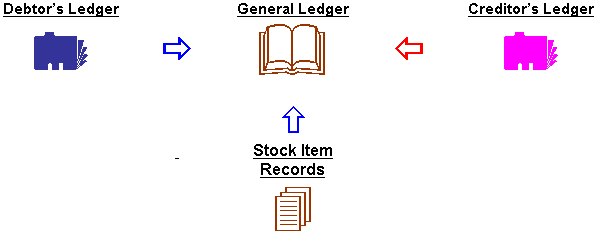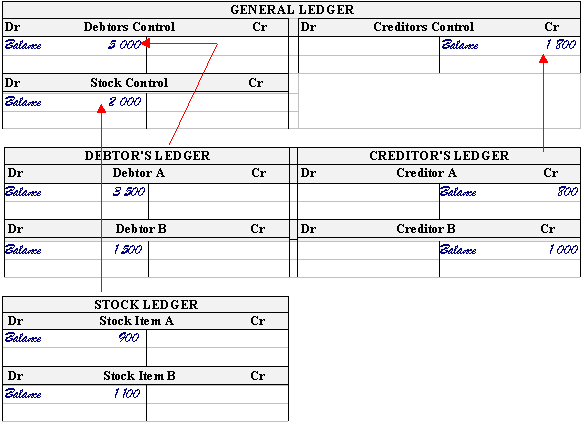
In the General Ledger, you would only have one debtor’s account and one creditors account. If you sell on credit to your customers, how will I keep track of each of the individual debtors’ accounts? If you buy on credit from your suppliers, how will you keep track of each of the individual creditors’ accounts? If you trade with stock items, how will all the hundreds of stock items fit into the general ledger? How will they fit into your chart of accounts? Only the total of all individual debtor's accounts and the total of all individual creditor's accounts and the total of your individual stock item records are listed in the trial balance and in the financial statements.
Imagine what the size of your general ledger would be if you have 800 debtor accounts, 400 creditor accounts and 200 stock items. If you open ledger accounts for each of your individual debtors and creditors and stock items in the respective subsidiary ledgers, your general ledger would have approximately 1 400 less accounts. But you will have 3 more ledgers in which you can manage and store specific information regarding each of the accounts for your debtors, creditors and stock items. Only the total of each of these 3 ledgers will be reflected in your general ledger, trial balance and balance sheet. you will also have a separate chart of accounts or a list of all your debtors, creditors and stock items.
Another benefit of control accounts is, that in large business enterprises, you may delegate the subsidiary ledgers to the debtor's clerk who can manage and balance the debit and credit entries in the individual ledgers accounts and compile a list of the balances at the end of a period. These balances must then balance with the debtors control account. The debtor's clerk can also use the ledger accounts for credit control and to collect the debt. The same principles may apply for the purchases department.

In the General Ledger you would keep the control accounts regarding your debtor accounts, creditor accounts and the stock items (if you trade in stock items). The details are kept in the individual subsidiary ledgers (debtor's ledger, creditor's ledger and stock ledgers). The subsidiary ledgers and the general ledger can be illustrated as follows:

The debtors control account reflects the total amount owed by
the all the individual debtors. The balance of the debtor’s control account
must equal the total of the debtors’ list, which represents the amounts owed
by the individual debtors obtained from the individual balances in the various
subsidiary ledger accounts for each debtor. This subsidiary ledger is known as
the debtors' ledger. In the debtors' ledger, the transaction details and
additional information regarding each debtor such as their personal and
contact information, credit limit, terms, etc. may be stored. This debtors'
ledger is also a register of each and every transaction that you and a
specific debtor entered into. The creditors control account reflects the total amount owed
to all the individual creditors. The balance of the creditor’s control account
must equal the total of the creditors list, which represents the amounts owed
by the individual creditors obtained from the individual balances in the
various subsidiary ledger accounts for each creditor. This subsidiary ledger
is known as the creditors' ledger. In the creditors' ledger, the transaction details and
additional information regarding each creditor such as their personal and
contact information, credit limit, terms, etc. may be stored. This creditors'
ledger is also a register of each and every transaction that you and a
specific creditor entered into.
The stock control account reflects the total amount or value of all stock items. The balance of each of the individual stock item ledger accounts or records must equal the total of the stock item list, which represents the amounts or value of the individual stock items obtained from the individual balances in the various subsidiary ledger accounts for each stock item. This subsidiary ledger is known as the stock item ledger.
In the stock ledger, the transaction details and additional information regarding each stock item such as the cost prices, selling prices, quantities, and location on the shelves, etc. may be stored. This stock ledger is also a register of each and every stock transaction, how many items are purchased, sold, etc.